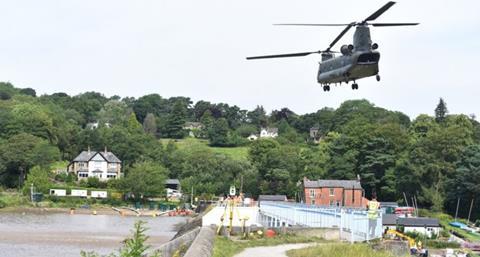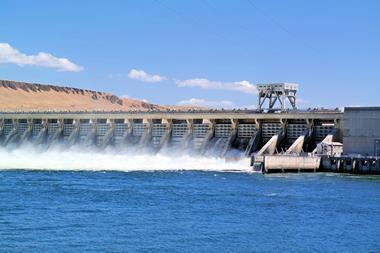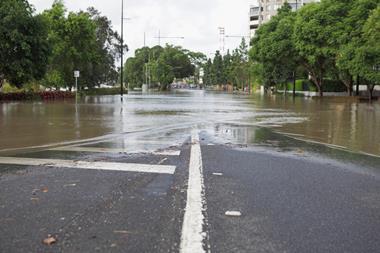As the insurance industry braces for a surge of claims following the partial collapse of Whaley Bridge dam last week, what can it learn to better prepare for extreme weather events?
The insurance industry is preparing itself for a surge in claims following Whaley Bridge’s dam in Derbyshire partially giving way last week on Thursday.
Police told the town’s 6,500 residents to evacuate their homes and gather at a school amid a severe flood warning, according to BBC News.
Part of the bridge’s reservoir spillway collapsed after being battered by heavy rainfall earlier last week. The Environment Agency said that 85% of people in Whaley Bridge have left their homes.
Meanwhile, in North Yorkshire, a months rainfall in four hours saw the collapse of Grinton Moor Bridge, between Reeth and Leyburn.
It follows a letting agent coming under fire over an insurance offer to the Whaley Bridge residents.

Flooding events in general are more difficult to understand than other types of extreme weather as they depend on the amount and intensity of rainfall, local topography and geology.
But as extreme weather events such as flash flooding become more frequent, and with extreme weather claims accounting for large financial losses for insurers, what can the insurance industry learn from the event? And how can it better prepare for something that cannot be predicted?
Claims surge
Catherine Bell, chairman of property underwriting agency, Magenta Insurance told Insurance Times that “there is sure to be an increase in claims”.
She questioned whether home insurance policies would cover this as residents had been evacuated from their homes. The firm has deployed measures to prioritise its policyholders, brokers and insurers by pulling together a planned approach for all connected parties.
She said: “It is also a scenario where important and valuable lessons can be learned. It also may affect cover, terms, and premiums being offered in that area in the future because of the increased risk of insuring those properties.”
Magenta has been in touch with Biba on the matter who have been working with brokers.
Tricky underwriting
Karl Eltman, head of complex risk at inet3 – the name which Magenta Insurance trades under, has been in direct contact with brokers that the firm works with in the area.
He said: “Whenever there is extreme weather, there are always a lot of claims coming off the back of it because, unfortunately, there are areas of flooding that we are not used to.
“From an underwriter’s perspective we can make a judgement based on statistics in the local area, looking at the geography of the land and underwrite appropriately but when something like a reservoir or a dam fails there’s nothing you can do about that.
“I would think that the people of Whaley Bridge have not had trouble getting insurance as its not a flood registered area. Hopefully it might encourage some more broker activity, there’s a crucial link [in] providing the right cover on the right basis.”
He explained that there are many people seeking cover through aggregators which means that policies are not always on the right basis. Eltman hopes that the event will be of benefit to brokers as it should see more people seek their advice in order to make sure they have the right cover.
Overall, Eltman said that events such as this, from an underwriting perspective, makes things incredibly difficult as you cannot anticipate them.
In terms of the loss, he said that it could be catastrophic.
Raised questions
Bell believes certain questions are raised from this matter, and that there are other scenarios where “people may be told by the authorities to leave their homes for an uncertain period of time especially where life may be in danger.”
She said: “I think it is important for insurers, brokers and MGAs to review policy cover and to understand before whether damage has happened to a home, or business.”
Speaking of the current situation for the residents in Whaley Bridge area, she urged the industry to think about alternative accommodation costs being covered in the policy, and to have a plan in place if these residents cannot go back to their homes should the situation worsen.
Magenta said it will be reviewing matters and working to ensure that its clients are supported wherever possible.
“Furthermore, businesses caught up in this incident are also losing income and so of course the impact is huge on people homes and businesses in the affected area. They may well have had to deploy their disaster recovery plans to keep their businesses going where possible,” Bell added.
Working with providers
Eltman mentioned one broker in the Whaley Bridge area whose business was affected by the flooding, but is currently conducting business as usual.
Crawford & Co, like Magenta, agreed that a claims surge would follow this incident.
The loss adjuster has mobilised its adjusted responses teams and WeGoLook [mobile technology company and on-demand workforce that gathers information for businesses] to deal with this surge from the North-East to the North-West of England.
Paul Bowyer, managing director in claims solutions at Crawford & Co, said that the firm is working with its providers to secure accommodation for all policyholders affected by flood in the region.
“We have provided initial assistance to the majority to homeowners, businesses and farmers where access is possible. We also have contractors from our managed repair service, Contractor Connection, on standby to provide emergency repairs, drying out and clean-up services in Whaley Bridge,” he said.
Crawford & Co will be using drone technology to collect information when it gets permission to enter the controlled zone, but last week there was a 1km restriction zone that was manned by the police and emergency services.
Extreme weather events in the UK:
- Drought: 2004-06 was one of the driest periods on record in the UK. South-East England suffered due to a few reservoirs in the area and a heavy reliance on groundwater supplies.
- Flash floods: A month’s rainfall in four hours saw Grinton Moor Bridge in North Yorkshire collapse in July 2019.
- Strong winds and storms: Last March, Storm Freya swept across Wales, South-West England, the Midlands, Northern England, Southern England and Scotland with 76mph winds. Storm Emma saw the AA estimate a £35m surge in motor clams.
- An extreme cold spell: A cold snap dubbed the Beast from the East in February 2018 caused by Siberian winds being pushed into the east saw temperatures plummet below zero and covered parts of the UK in a thick blanket of snow
- An extreme heat wave: This July saw temperatures peak at 38.1C. Britain experienced its hottest July day and the second hottest day on record according to the Met Office.
Jeremy Trott, head of claims operations at Allianz said the insurer also has loss adjusters at the ready after establishing that 33 customers were at risk in the surrounding area.
Meanwhile, AXA is contacting aproximately one hundred customers in the area to offer assistance. In January, Zurich’s group chief risk officer Alison Martin urged brokers to take particular notice of flood risk in the UK.
Losses
RSA’s Q1 results in 2018 was impacted by bad winter weather in the UK and abroad, including the Beast from the East.
Direct Line spent an entire £50m weather budget on Beast from the East claims last year in May.
In April this year, Covea’s home insurance line saw claims for the Beast from the East and subsidence pushing the book into a 106.1% COR.
Hosted by comedian and actor Tom Allen, 34 Gold, 23 Silver and 22 Bronze awards were handed out across an amazing 34 categories recognising brilliance and innovation right across the breadth of UK general insurance.





















































No comments yet